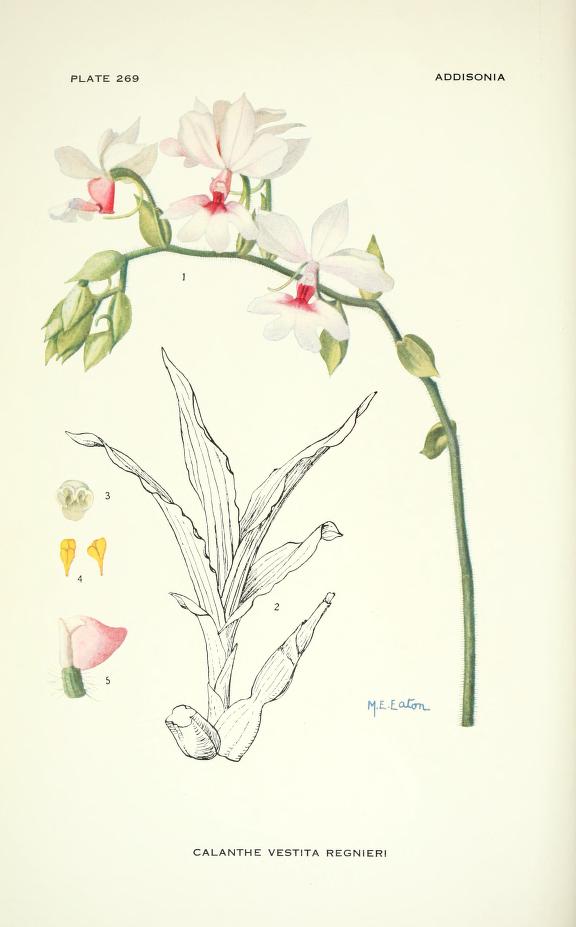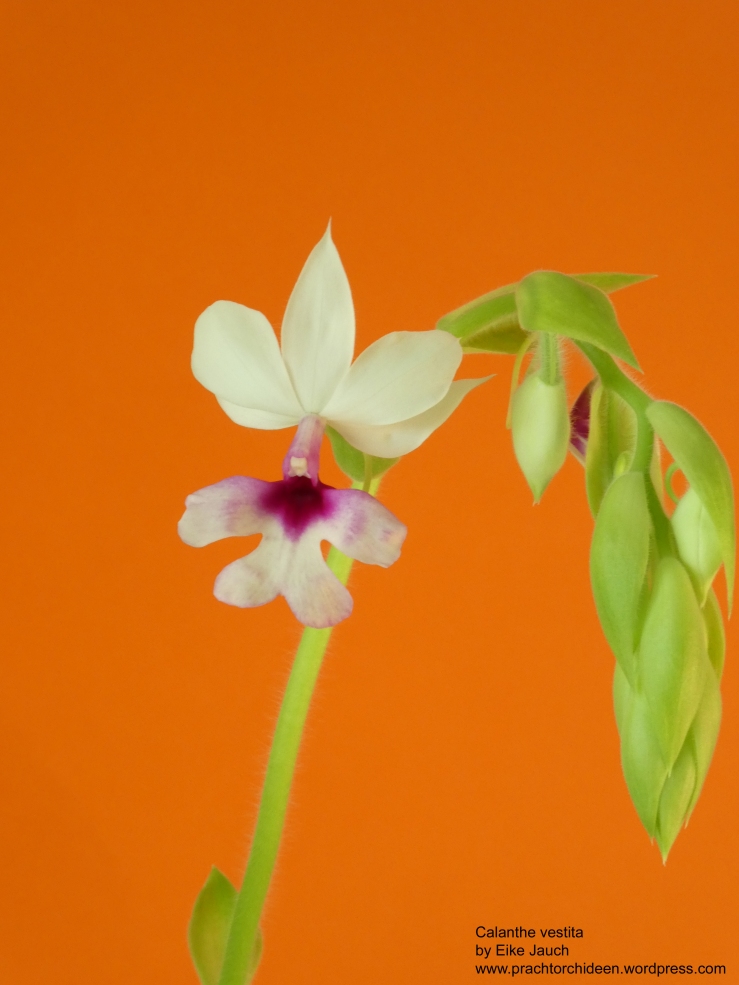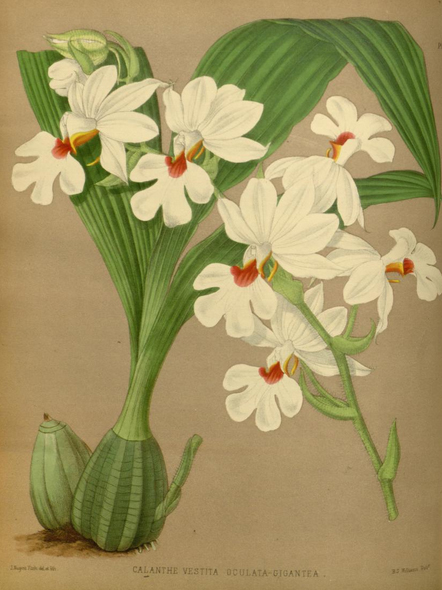
It is well known that there are different varieties of Calanthe vestita in culture. However, it is quite hard to find out how these varieties might look like. I therefore searched literature for descripions of these varieties.
In “Addisonia: colored illustrations and popular descriptions of plants”, v8 (1923), Calanthe vestita var. regnieri was described as follows:
“CALANTHE VESTITA REGNIERI
Regnier’s Calanthe, native of Cochin-China
The history of Calanthe vestita carries us back to the early days of orchid culture. It was originally discovered by Dr. Nathaniel Wallich in Tenasserim some time in 1826, but was not introduced to horticulture until 1848 when Dr. Kane sent living specimens to England from Moulmein [remark: Mawlamyaing, also written by Mawlamyine, is the third largest city in Burma. At the time of British rule, the city was called Moulmein]. The variety Regnieri was found in Cochin-China and offered for sale in 1883 in London. Calanthe vestita and its varieties have entered largely into the production of garden hybrids, the best known of these hybrids being Calanthe Veitchii which was raised in 1856 in the same year that Calanthe Dominyi, the first artificially produced orchid hybrid, made its appearance. The varieties of Calanthe vestita are chiefly distinguished by the colors of the flowers.

Explanation of plate
Fig. 1 . — Scape with raceme.
Fig. 2. — Pseudobulbs, with new growths of leaves from the base.
Fig. 3. — Anther.
Fig. 4. — Eight pollen-masses, x4.
Fig. 5. — Base of labellum, x2.
The variety Regnieri is usually characterized by the less deeply lobed lip which is rose color with a rose-purple blotch at the base and by the rose-purple claw. The variety itself is variable and several so-called sub-varieties have been recognized in horticultural practice. Examples of these are Sander’s variety in which the flowers are rosy carmine, Stevens’ variety in which the flowers are white with a small rose-colored blotch on the disc of the lip, and Williams’ variety which has the petals and lateral sepals pencilled with rosy carmine, the lip being deep carmine with a crimson-purple blotch on the disc. As Calanthe vestita is a native of the hot tropics it should be cultivated in company with East Indian plants. After flowering the pseudobulbs should be allowed a period of rest. The pale greenish gray pseudobulbs of Regnier’s Calanthe are elongate, bluntly angulate, and constricted near the middle. The leaves appear after the flowers and are broadly lanceolate, tapering gradually to an acute tip. The peduncle is erect, very hairy, and terminates in a loose raceme of large, showy flowers. The sepals and petals are subequal and elliptic in outline. The lip is flat, conspicuously four-lobed, with a slender greenish spur at the base. The column is fleshy and usually deeply stained with carmine. Oakes Ames.”
Additional varieties of Calanthe vestita were described in 1894 in “The Orchid-grower’s Manual: Containing Descriptions of the Best Species and Varieties of Orchidaceous Plants in Cultivation”:
Calanthe vestita, Lindley:
A deciduous species of great beauty, and exceedingly valuable for decorative purposes. It has large squarish silvery grey pseudobulbs, broadly lanceolate nervose leaves, which grow up and become matured after the flowering is over, and tall radical scapes of charming creamy white flowers, which in some forms have a coloured spot on the base of the lip. The forms which usually represent the type in collections are those named luteo-oculata and rubro-oculata, which are more fully described below. No collection should be without the varieties of this plant, which are all such fine subjects for winter blooming, and so useful for cutting for room decoration, that one cannot have too many of them. We have had plants of this species with thirty spikes, and frequently he spikes have borne from twenty to thirty flowers on each, continuing in perfection for three months. The varieties mentioned below are all of a highly ornamental character. – India; Moulmein.

Calanthe vestita fournierii, Rolfe
This variety is described by Mr. Rolfe in the Gardener’s Chronicle, 1892, xi. p. 488 as follows: – “The flowers range from one and a quarter to one and a half inches across their broadest diameter; they also vary in colour from pure white to blush and pink to a deep rose pink; with a column and lip of a deeper shade, the latter forms recalling Calanthe Veitchii rather than Calanthe vestita, with its white sapals and petals.” – Borneo
Calanthe vestita igneo-oculata, Rchb. f.
This variety has been exhibited by Sir Trevor Lawrence, Bart., M.P., and it is said to be quite distinct, the base of the column being purplish, over which is a dazzling flame colour; it is a much stronger grower than Calanthe vestita rubro-oculata, and retains its foliage until it flowers. – Borneo
Calanthe vestita luteo-oculata, Veitch
A charming variety, in which the sepals and petals are white, and the lip is of the same coulour, with a blotch of yellow in the centre. The flower spikes are produced from October to February, and are very durable; it is nearly equal to C. vestita rubro-oculata in point of beauty, and is very useful for winter decoration. – Burmah

Calanthe vestita oculata giganteae, Rchb. f.
This is a very showy Calanthe, and, like Calanthe Turneri and Calanthe Williamsii, blooms after the other varieties are over. It is a strong grower, and the foliage remains green during the time of flowering. It yields gracefully arching spikes from three to four feet long, which produce an abundance of large flowers of a soft creamy white colour with a white lip, the base of the column blotched with dazzling fiery red.

It blooms in March and April, and lasts in perfection for a long period. This fine variety was exhibited by the late Mr. Spiers, when gardener to Sir Trevor Lawrence, Bart., and received a 1st Class Certificate. We learnt from Mr. Spiers that Calanthe vestita oculata giganteae, when in full beauty, bore on one spike as many as thirty expanded flowers, with more to open, whilst the leaves were still green. “The bulb carrying the spike,” he wrote. ” is now breaking freely, so that it would appear that it will require no rest. I shall simply re-pot it without disturbing the roots. A curious fact with this variety is that its roots remain plumb, and do not die off every year as in the old species.” – ? Borneo
Calanthe vestita var rubro-oculata, Veitch
A charming free-flowering deciduous orchid, producing, from October to February, long drooping flower spikes, which are clothed with soft white hairs, and rise from the base of the silvery green pseudobubs before the latter produce their leaves. The flowers are upwards of two inches across; the sepals and petals delicate white, the lip of the same colour, with a blotch of rich crimson in the centre. – Moulmein

[…] https://prachtorchideen.wordpress.com/2019/02/02/varieties-of-calanthe-vestita/ […]
LikeLike
[…] https://prachtorchideen.wordpress.com/2019/02/02/varieties-of-calanthe-vestita/ […]
LikeLike
[…] https://prachtorchideen.wordpress.com/2019/02/02/varieties-of-calanthe-vestita/ […]
LikeLike
[…] https://prachtorchideen.wordpress.com/2019/02/02/varieties-of-calanthe-vestita/ […]
LikeLike
[…] https://prachtorchideen.wordpress.com/2019/02/02/varieties-of-calanthe-vestita/ […]
LikeLike
[…] https://prachtorchideen.wordpress.com/2019/02/02/varieties-of-calanthe-vestita/ […]
LikeLike
[…] https://prachtorchideen.wordpress.com/2019/02/02/varieties-of-calanthe-vestita/ […]
LikeLike
[…] https://prachtorchideen.wordpress.com/2019/02/02/varieties-of-calanthe-vestita/ […]
LikeLike
[…] https://prachtorchideen.wordpress.com/2019/02/02/varieties-of-calanthe-vestita/ […]
LikeLike